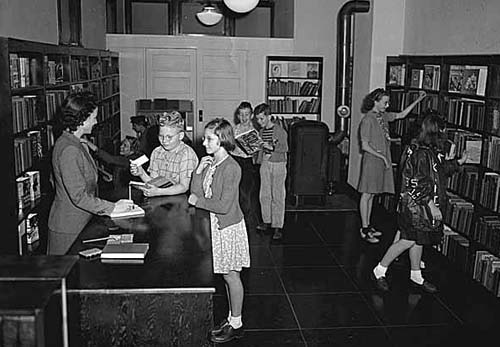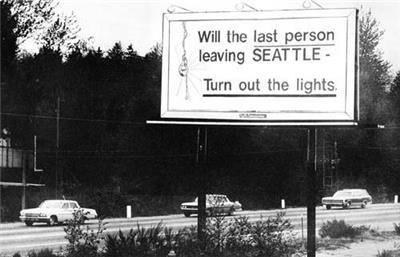
Coming soon!
8473 HistoryLink.org articles now available.
Diablo Dam incline railway climbing Sourdough Mountain, 1930. Courtesy Seattle Municipal Archives, 2306.
Children waving to ferry, 1950. Courtesy Museum of History and Industry.
Loggers in the Northwest woods. Courtesy Washington State Digital Archives.
4/10/2025

National Library Week
This week is National Library Week, and HistoryLink checks out the Seattle Public Library, which got its start in the 1860s. Running a library was tough in a frontier town, and after a brief period of inactivity the Seattle Library Commission opened a reading room in 1891, then found a home for the collection in the Yesler Mansion. Unfortunately, the mansion burned to the ground in 1901. A new Carnegie-funded library opened downtown a few years later.
In 1903 the library opened its first branch in converted apartments in Fremont. From these humble beginnings, the branch later moved to its current location in 1921, by which time the central library had expanded into other neighborhoods. Within decades, branch service was available throughout the city. In 1960, the central library was replaced with a more modern building.
By the century's end, many of the branch libraries were showing their age and were also in need of new collections and new technology. In 1998 Seattle voters approved a $196 million bond measure to help rebuild the city's public libraries. The Seattle Public Library Foundation added $83 million to complete the building program, and Bill and Melinda Gates donated $20 million in what was then the largest private gift to a public library in American history.
The centerpiece of the "Libraries for All" project was the new Central Library, which opened in 2004 to architectural acclaim. Four new branch libraries were built – the Delridge Branch, the International District/Chinatown Branch, the Northgate Branch, and the South Park Branch – and some of the other branch libraries were replaced by newer buildings: the NewHolly Branch, the Wallingford Branch, the Capitol Hill Branch, the High Point Branch, the Beacon Hill Branch, the Greenwood Branch, the Ballard Branch, and the Montlake Branch.
Other branches were renovated and/or expanded – the Rainier Beach Branch, the Green Lake Branch, the West Seattle Branch, the North East Branch, the Columbia Branch, the Lake City Branch, the Douglass-Truth Branch, the Southwest Branch, the Queen Anne Branch, the University Branch, the Broadview Branch, the Madrona-Sally Goldmark Branch, the Magnolia Branch, and, the Fremont Branch.
National Poetry Month
April is National Poetry Month, and we note some of the poets who found inspiration here in Washington, beginning with Ella Rhoads Higginson, the state's first poet laureate. Higginson achieved fame in the 1890s for her short stories and poetry, and later served as campaign manager for Frances Axtell, who was one of the first two women elected to serve in the Washington State Legislature. Another poet who was involved in political activism was Carlos Bulosan, a Filipino cannery worker who became active in the labor movement.
Theodore Roethke was a Pulitzer Prize winning poet who taught English at the University of Washington up until his untimely death in 1963. While at UW, Roethke occasionally enjoyed his off hours at the Blue Moon Tavern, a favorite haunt for other local poets, such as Richard Hugo and David Wagoner.
Other poets who have called Washington their home include Glenn Hughes, also a pioneer of the "theater in the round"; prize-winning playwright August Wilson; Tomas Gayton, the grandson of Black pioneers; and Lucia Perillo, a Pulitzer Prize finalist who also received a MacArthur Foundation "genius grant" in 2000 for her writing.
Seattle has also had a vibrant slam poetry scene, as well as resources for poets, such as the "It's About Time" writers reading series, and Open Books, one of two all-poetry bookstores in the nation. Researchers will enjoy looking through back issues of Poetry Northwest, the longest running poetry-only magazine in the United States, which published its last issue in Seattle in 2002. And aspiring poets would do well to attend the annual LiTFUSE poetry workshop, held each fall in Tieton.
On April 15, 1888, Spokane entered a new era of transportation with the launch of the city's first streetcar. Local residents lined Riverside Avenue to see or ride on the new conveyance, which traveled one mile and ended at a new development called Browne's Addition. The developers paid to have the streetcar line built, primarily to sell real estate.
On April 11, 1897, the USS Oregon became the first in a long line of battleships to dock at the Puget Sound Naval Shipyard in Bremerton. Nearly a century later, on April 12, 1992, the shipyard welcomed home the USS Missouri for deactivation and storage, but the historic vessel didn't stay long.
The sinking of the Titanic on the night of April 14-15, 1912, sent ripples as far away as Puget Sound. Six Washingtonians went down with the "unsinkable" ocean liner, including filmmaker William Harbeck, who had filmed such historic events as the 1909 Alaska-Yukon-Pacific Exposition and Washington's first airplane flight. Harbeck's body was recovered, but his motion pictures have disappeared from view.

On April 16, 1971, this billboard appeared in response to the Boeing Bust.
"Whatever the cost of our libraries, the price is cheap compared to that of an ignorant nation."
—Walter Cronkite